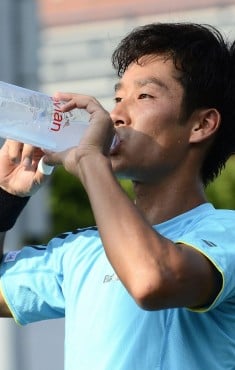Nutrition is extremely important for athletes to perform up to their potential, and improper nutrition can actually be dangerous and lead to sports injuries. For youth athletes who participate in sports programs, a healthy diet is even more important. Youth athletes are not only putting extra stress on their bodies, but they’re also growing rapidly, and they’re at greater risk of injury than fully-developed athletes. They need extra calories, vitamins, and minerals to get through physically demanding practices, support healthy growth, and help prevent injuries[1]. Does your child know the importance of proper sports nutrition for youth athletes? Do they know what foods they should be eating to perform up to their potential?
Would you prefer to read this article as an eBook PDF? Click below to download for free.
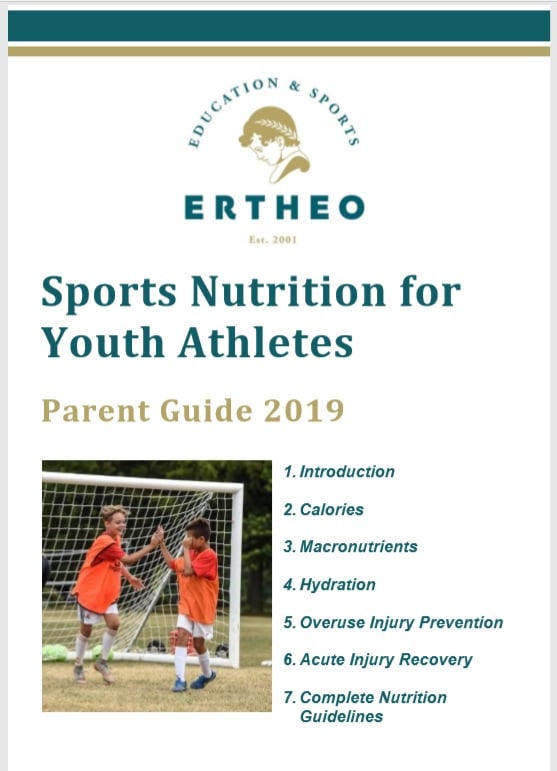
It seems that youth coaches might be neglecting the importance of proper sports nutrition for youth athletes. We recently surveyed youth soccer coaches to find out whether they encourage their players to eat healthy and drink water, and only 61% of coaches reported doing so. While still the majority, that number is surprisingly low, especially when you take into account that nutrition education should go beyond simple encouragement, and coaches should actually be educating their players about proper nutrition for soccer players. They should be teaching them what to eat, how much to eat, when, and why it’s so important.
Fortunately, as a parent, you can have a huge impact on your child’s nutrition. In this article, you’ll learn all about sports nutrition for youth athletes. You’ll learn how many calories your child should be eating, the proper ratio of macronutrients (carbohydrates, fats, and proteins) according to their energy expenditure, and what vitamins and minerals can help them grow into healthy, strong, and successful athletes. Then, we’ll talk about youth sports injuries and how nutrition plays a role in both prevention and recovery.
The next time you pack your child’s lunch box, bring them a pre-game snack, or notice your child filling up on ice cream before dinner, keep this information in mind.
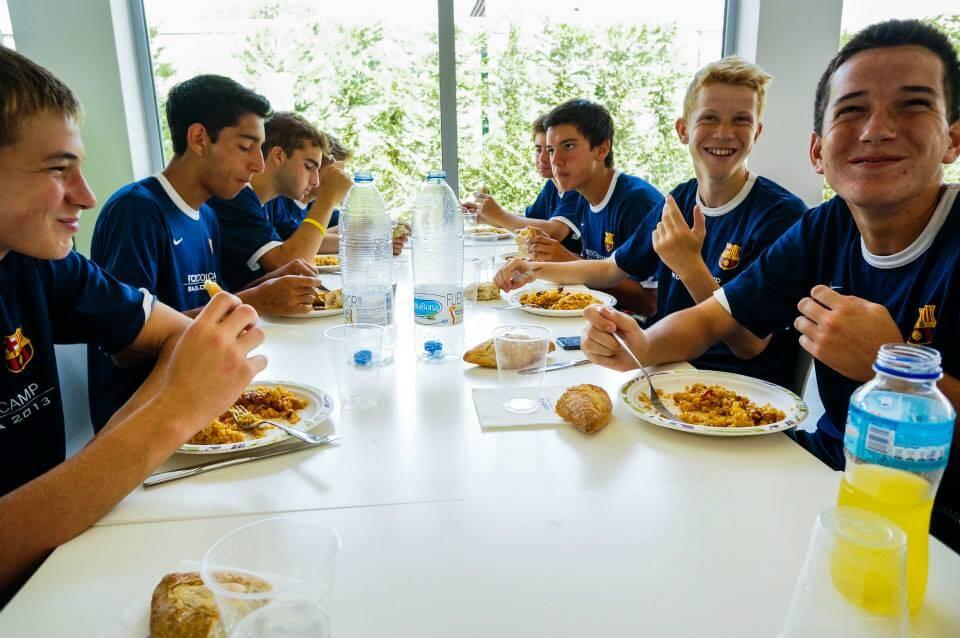
Calories
Let’s talk about calories first. Calories measure the energy that your child gets from their food. They need food and a specific amount of calories to have sufficient energy to get through the day. As your child engages in any activity from walking the dog, to studying for a test, to attending soccer practice, they burn calories. They even burn calories from involuntary activities like breathing and growing.
Depending on your child’s unique genetics and their level of activity throughout the day, they’ll need to consume a certain amount of calories to have enough energy to sustain them. Youth athletes who participate in sports programs should consume more calories than inactive children so they have enough energy to get through their sports training.
The chart below represents caloric intake recommendations for boys and girls from 4 to 18 years old from the USDA.[2]
| Boys | Not active | Somewhat active | Active |
| 4 – 8 years old | 1,200–1,400 calories | 1,400–1,600 calories | 1,600–2,000 calories |
| 9 –13 years old | 1,600–2,000 calories | 1,800–2,200 calories | 2,000–2,600 calories |
| 14 – 18 years old | 2,000–2,400 calories | 2,400–2,800 calories | 2,800–3,200 calories |
| Girls | Not active | Somewhat active | Active |
| 4 – 8 years old | 1,200–1,400 calories | 1,400–1,600 calories | 1,400–1,800 calories |
| 9 – 13 years old | 1,600–2,000 calories | 1,600–2,000 calories | 1,800–2,200 calories |
| 14 – 18 years old | 1,800 calories | 2,000 calories | 2,400 calories |
According to the USDA, to qualify as an active child, your child should be walking for at least 40 minutes a day. That being said, most children participating in youth sports qualify as active children. Eight to 10-year-old soccer players of average height and weight burn anywhere from 200 to 400 calories per hour of play. Fourteen to 15-year-old soccer players burn between 325 and 670 calories per hour of play.[3] Most high-school players practice for three hours a day which means they could be burning up to 2000 extra calories per day.
Active, growing athletes should never experience a calorie deficit. According to research from the Dietitians of Canada, the American Dietetic Association, and the American College of Sports Medicine, energy deficits can cause short stature, delayed puberty, menstrual dysfunction, loss of muscle mass, and increased susceptibility for fatigue, injury, or illness.[4]
Click one of the sports below to see how many calories your child is burning while playing their sport. Be sure to adjust the weight and the amount of time they spend practicing for more accurate results. Accuracy is not guaranteed.
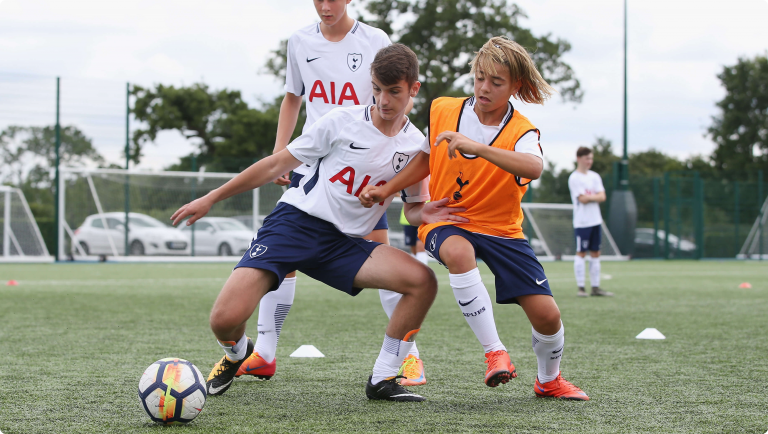
Macronutrients
Macronutrients or carbohydrates, fats, and proteins are the main suppliers of nutrients in your child’s diet. Each macronutrient has a slightly different function to provide your child with the energy they need to perform. It’s important to consider what percentage of your child’s daily caloric intake comes from carbohydrates, proteins, and fats to make sure they’re performing their best.
Carbohydrates are an athlete’s main source of energy. Proteins build and repair muscles, nails, hair, and skin. And, fats absorb vitamins and protect vital organs. To increase energy and promote healthy recovery after working out, young athletes need to consume a higher percentage of carbohydrates and protein than the average adult.
Here’s how average American adults eat [5]:
| Macronutrient | Percentage estimate |
| Carbohydrates | 49% |
| Proteins | 17% |
| Fats | 34% |
Here’s what proper sports nutrition for youth athletes looks like [6]:
| Macronutrient | Percentage estimate |
| Carbohydrates | 60% |
| Proteins | 15% |
| Fats | 25% |
Based on the charts above, youth athletes who participate in sports programs should increase their carbohydrate intake and their protein intake. It may look like you should also encourage your child to eat less fatty foods, but this probably isn’t necessary. As mentioned in the previous section, your child should also be increasing their overall calorie-consumption. So if they simply focus on eating a lot more carbohydrates and a little more protein without changing their fat intake, their calorie-consumption should increase and their macronutrient ratio should improve.
The chart below with food lists from healthyeater.com shows which foods are rich in carbohydrates, proteins, and fats. Remember, to ensure your child has enough energy for practice and recovery, they should be eating more carbohydrates and protein.
| Carbohydrates | Carbohydrates from fruits | Proteins | Fats |
| Oatmeal | Grapefruit | Eggs | Flaxseed |
| Yams | Apples | Chicken breast | Almonds |
| Brown rice | Blueberries | Salmon (wild Alaskan) | Avocado |
| Sweet potatoes | Cantaloupe | Turkey breast | Olive oil |
| Multigrain hot cereal | Oranges | Canned tuna (solid white) | Walnuts |
| White potatoes with skin | Bananas | Nuts (walnut, almonds, pecans) | Virgin coconut oil |
| 100% whole wheat bread | Peaches | Pumpkin Seeds | Salmon (wild caught) |
| 100% whole wheat pasta | Grapes | Tofu | Peanuts |
| Beans and lentils | Strawberries | Steak (grass fed beef) | Clarified butter |
| Cream of rice hot cereal | Pineapple | Flank steak (grass fed beef) | Ripe olives |
| Quinoa | Blackberries | Codfish | Peanut oil |
| Couscous | Plums | Greek yogurt | Hemp seed oil |
| Pumpkin | Pears | Rainbow trout | Pecans |
| Butternut squash | Acai berries | Broccoli | Almonds |
| Fresh Beets | Mango | Shrimp | Greek yogurt |
The South Jersey Elite Barons Club of the U.S. Soccer Development Academy wrote an excellent article about sports nutrition for youth athletes (specifically nutrition for soccer players) complete with meal plan recommendations. Click here to check it out.
Hydration
Proper hydration is an important part of proper sports nutrition for youth athletes. If your child drinks the right amount of fluids during their sports season, they’ll experience the following benefits [7]:
- Improved muscle function
- Increased energy
- Reduced risk of injury
- Improved recovery
- Regulated blood pressure
- Improved circulation
Likewise, dehydration can have a tremendously negative impact on your child’s performance and their health. According to Noel Williams, registered sports dietitian at children’shealth, “Almost every measurement of performance – aerobic endurance, strength, power, speed, agility and reaction time – decreases with as little as 2% dehydration.”
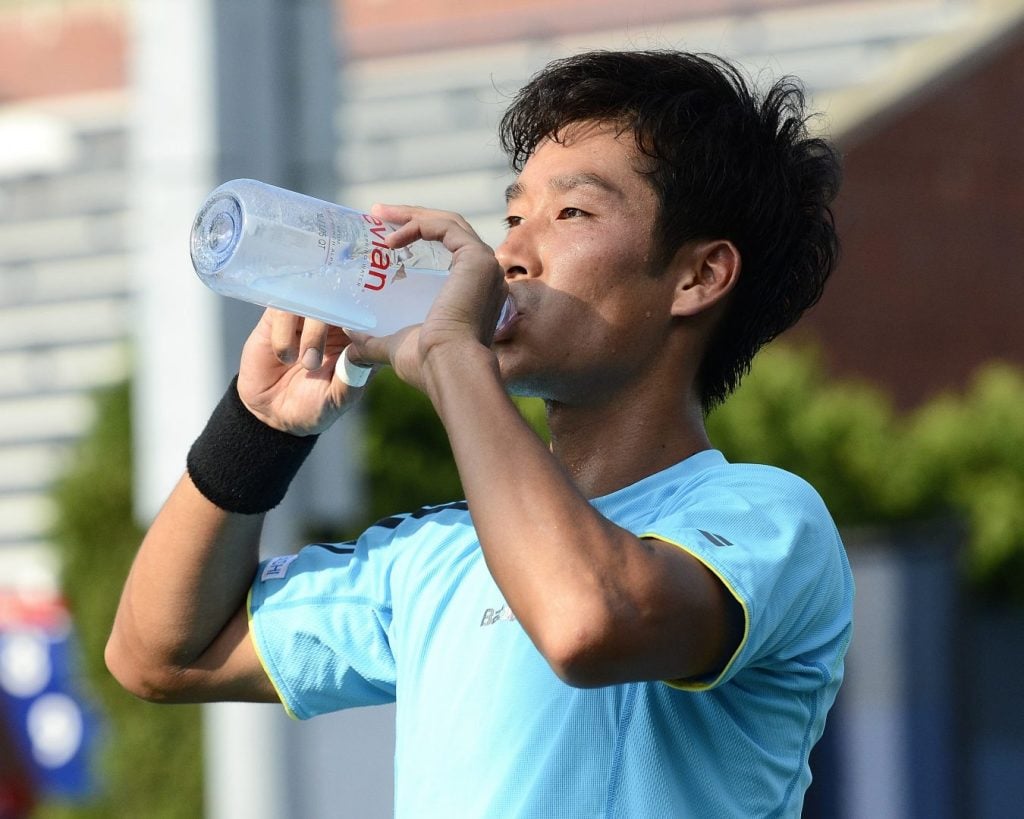
In general, dieticians recommend water as the primary source of fluid for athletes. However, some also endorse sports drinks for intense exercise lasting longer than an hour or intensely hot and humid conditions. The ideal sports drink contains about 6 – 8% of carbohydrates and a little bit of salt. You can find this information printed on the labels of sports drinks like Gatorade and Powerade.
The amount of fluids your child should drink depends on multiple factors including the climate in which they play and their height and weight. On average, here’s how much an active teenager should be drinking [8]:
| Timing | Amount |
| 2 – 3 hours before exercise | 1 full bottle of water (600 mL) |
| 15 minutes before exercise | 1/3 to 2/3 of a bottle of water (200 – 400 mL) |
| During exercise (every 15 – 20 minutes) | 1/4 to ½ of a bottle of water (150 – 300 mL) |
| After exercise | 2.5 bottles of water(1.5L) |
| Daily water (fluid) intake | A little more than 4 bottles of water (2.6L) |
You can have a great impact on your child’s performance by making sure they stay hydrated. Let them know why they should be drinking water, and use the chart above to tell them exactly how much they should be drinking and when.
Overuse injury prevention
Proper sports nutrition for youth athletes can help prevent overuse injuries. Before we talk about how, let’s talk about overuse injuries. What are they and how do they occur?
In the U.S., children from 5 to 14 years old account for nearly 40 percent (3.5 million per year) of all sports-related injuries treated in hospitals. High school students account for about 2 million sports-related injuries per year. Nearly half of those injuries are overuse injuries and are generally considered preventable.[9]
The most common overuse injuries in youth athletes include tennis elbow, swimmer’s shoulder, Little League elbow, runner’s knee, jumper’s knee, Achilles tendinitis, and shin splints. Let’s take a look at how overuse injuries occur and how nutrition plays a role in preventing them.
Unlike acute injuries which occur as a result of a single traumatic event, overuse injuries occur overtime as a result of repetitive physical stress on the bones, ligaments, and tendons. It’s normal for youth athletes to experience some physical stress during practices and games, and physical stress is usually beneficial. In fact, it’s a necessary component for building muscle.
After an intense practice or competition, your child’s muscle proteins are slightly damaged. This is why they might feel sore. During recovery, their bodies work hard to repair and replace those damaged muscle proteins. Muscle growth occurs when the rate of healing is faster than the rate of damage. Overuse injuries occur when breakdown occurs faster than the body can heal itself.[10]
Nutrition plays a vital role in healing your child’s muscles during recovery and preventing overuse injuries. For this to occur, your child should consume an adequate amount of protein (especially amino acids) and carbohydrates, and they should do it pretty quickly after working out.
Research suggests that while protein synthesis and healing continues for at least 48 hours after exercise, it’s important to consume these proteins and carbohydrates immediately after working out and especially within 2 hours. Otherwise, they could actually reverse muscle growth and damage their muscles even more.[11]
It’s clear that proper sports nutrition for youth athletes can help prevent overuse injuries from occurring. Did you know that proper nutrition can also help your child heal from acute injuries?
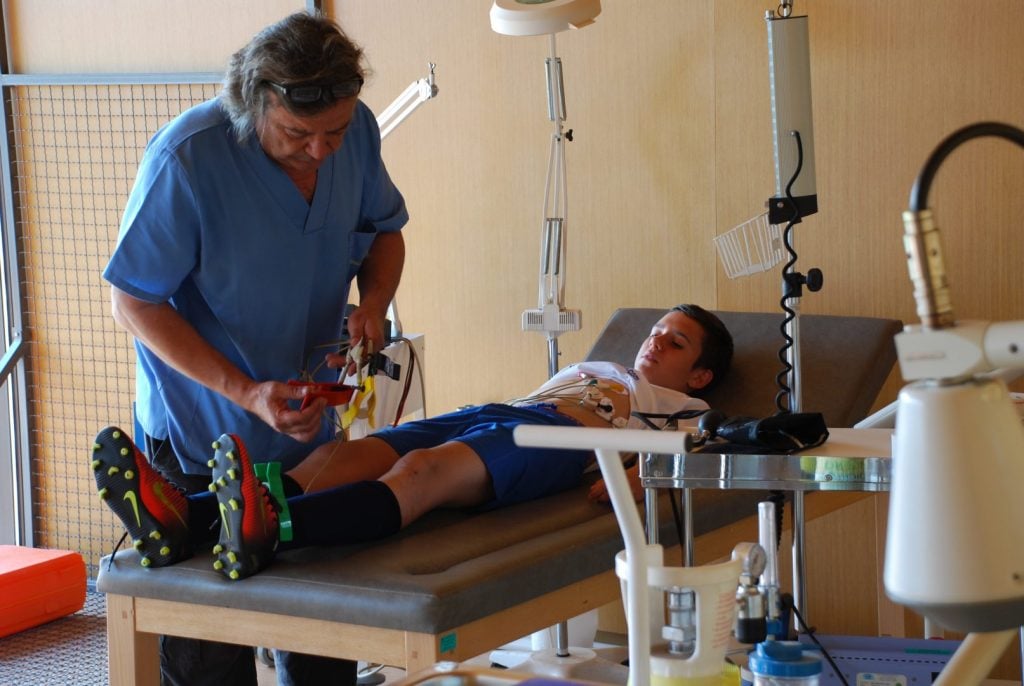
Acute injury recovery
Acute injuries occur from the result of sudden trauma to the body. Proper sports nutrition for youth athletes can help them heal faster from acute injuries.
For athletes younger than 14, the most common acute sports injuries include fractures of the ankle, elbow, forearm, knee, and wrist. For athletes older than 14, they are ankle fractures, ankle sprains, ACL injuries, and dislocations of the shoulder, kneecap, and collar bone. If overuse injuries are responsible for nearly half of all youth sports injuries, acute injuries are responsible for the other half.[12]
For a long time, the R.I.C.E method (Rest, Ice, Compress, and Elevate) has been considered the best first line of treatment for acute injuries. The P.O.L.I.C.E. principle (Protect, Optimal Loading, Ice, Compress, Elevate) is slowing replacing R.I.C.E., but both methods overlook the importance of proper nutrition immediately after injury and especially within 48 hours. Not to mention, proper nutrition is important during the entire recovery process – not just during the 48 hours immediately following injury.[13]
If your child suffers an acute injury, they’ll need extra energy to heal and recover. Within the first 48 hours of trauma, they should be consuming 20% more calories than usual. Likewise, certain foods can help speed up the healing process. Depending on the type of injury and the severity, your child should follow a specific diet plan to rebuild injured tissue, and preserve strength during recovery.[14]
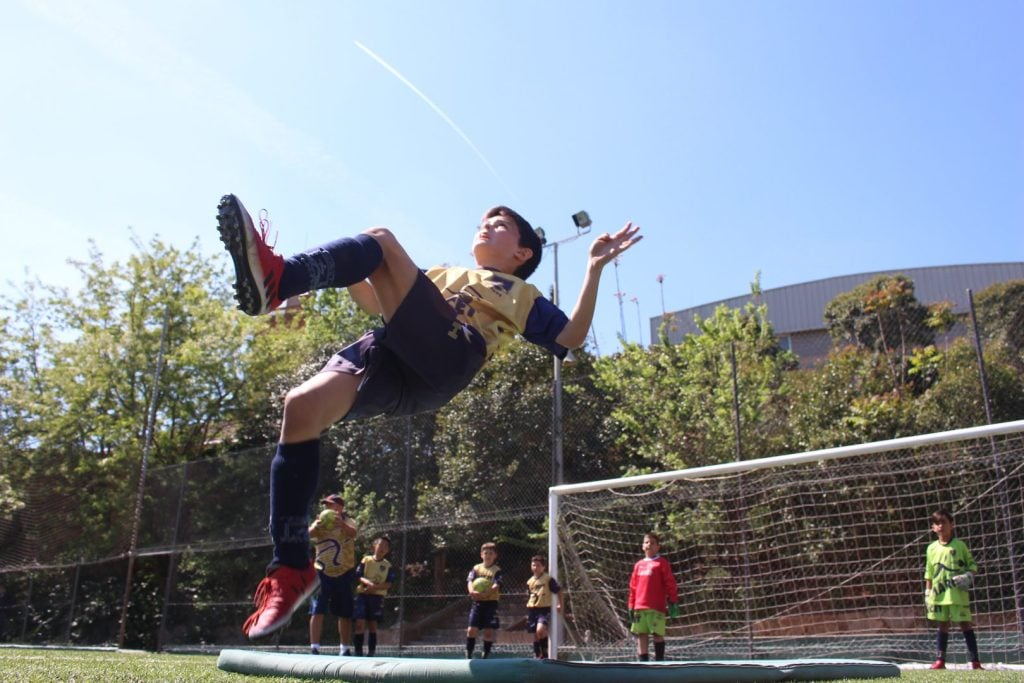
Crutches, for example, require a 20% caloric increase. A post-surgery meal plan should include probiotic-rich foods like yogurt, sauerkraut, and miso soup to balance out the antibiotics they’re taking to fight infection. Anti-inflammatory foods like olive oil, avocados, fish, nuts, and seeds can help alleviate pain, although they may also slow down the healing process.[15]
Proper nutrition can be the difference between a smooth and speedy recovery for your child and a long and drawn-out one. For more information about exactly what foods your child should be eating to promote healthy recovery, check out this report from the National Athletic Trainers’ Associating titled, Nutrition for Injury Recovery and Prevention.
Sports nutrition for youth athletes – Snapshot
Click below to download the general nutrition guidelines for youth athletes. No email required.
DOWNLOAD – GENERAL NUTRITION GUIDELINES FOR YOUTH ATHLETES
Calories
| Boys | Not active | Somewhat active | Active |
| 4 – 8 years old | 1,200–1,400 calories | 1,400–1,600 calories | 1,600–2,000 calories |
| 9 – 13 years old | 1,600–2,000 calories | 1,800–2,200 calories | 2,000–2,600 calories |
| 14 – 18 years old | 2,000–2,400 calories | 2,400–2,800 calories | 2,800–3,200 calories |
| Girls | Not active | Somewhat active | Active |
| 4 – 8 years old | 1,200–1,400 calories | 1,400–1,600 calories | 1,400–1,800 calories |
| 9 – 13 years old | 1,600–2,000 calories | 1,600–2,000 calories | 1,800–2,200 calories |
| 14 – 18 years old | 1,800 calories | 2,000 calories | 2,400 calories |
Macronutrients
| Macronutrient | Percentage estimate |
| Carbohydrates | 60% |
| Proteins | 15% |
| Fats | 25% |
| Carbohydrates | Carbohydrates from fruits | Proteins | Fats |
| Oatmeal | Grapefruit | Eggs | Flaxseed |
| Yams | Apples | Chicken breast | Almonds |
| Brown rice | Blueberries | Salmon (wild Alaskan) | Avocado |
| Sweet potatoes | Cantaloupe | Turkey breast | Olive oil |
| Multigrain hot cereal | Oranges | Canned tuna (solid white) | Walnuts |
| White potatoes with skin | Bananas | Nuts (walnut, almonds, pecans) | Virgin coconut oil |
| 100% whole wheat bread | Peaches | Pumpkin Seeds | Salmon (wild caught) |
| 100% whole wheat pasta | Grapes | Tofu | Peanuts |
| Beans and lentils | Strawberries | Steak (grass fed beef) | Clarified butter |
| Cream of rice hot cereal | Pineapple | Flank steak (grass fed beef) | Ripe olives |
| Quinoa | Blackberries | Codfish | Peanut oil |
| Couscous | Plums | Greek yogurt | Hemp seed oil |
| Pumpkin | Pears | Rainbow trout | Pecans |
| Butternut squash | Acai berries | Broccoli | Almonds |
| Fresh Beets | Mango | Shrimp | Greek yogurt |
Hydration
| Timing | Amount |
| 2 – 3 hours before exercise | 1 full bottle of water (600 mL) |
| 15 minutes before exercise | 1/3 to 2/3 of a bottle of water (200 – 400 mL) |
| During exercise (every 15 – 20 minutes) | 1/4 to ½ of a bottle of water (150 – 300 mL) |
| After exercise | 2.5 bottles of water(1.5L) |
| Daily water (fluid) intake | A little more than 4 bottles of water (2.6L) |
References
- https://www.orthology.com/injury-care-prevention/nutrition-for-injury-prevention/
- https://www.nhlbi.nih.gov/health/educational/wecan/downloads/calreqtips.pdf
- https://captaincalculator.com/health/calorie/calories-burned-playing-soccer-calculator/
- https://www.andeal.org/vault/2440/web/200903_NAP_JADA-PositionPaper.pdf
- https://www.cdc.gov/nchs/fastats/diet.htm
- https://www.sjeb.org/page/show/1225511-soccer-nutrition
- https://www.childrens.com/health-wellness/the-importance-of-hydration-for-young-athletes
- https://www.stopsportsinjuries.org/STOP/Resources/Statistics/STOP/Resources/Statistics.aspx?hkey=24daffdf-5313-4970-a47d-ed621dfc7b9b
- https://www.builtlean.com/2013/09/17/muscles-grow/
- https://www.precisionnutrition.com/about-post-workout-nutrition
- https://www.childrens.com/health-wellness/treating-common-acute-sports-injuries
- https://www.nata.org/sites/default/files/nutrition-for-injury-recovery-and-rehabilitation.pdf
- https://www.nata.org/sites/default/files/nutrition-for-injury-recovery-and-rehabilitation.pdf
- https://www.nata.org/sites/default/files/nutrition-for-injury-recovery-and-rehabilitation.pdf

